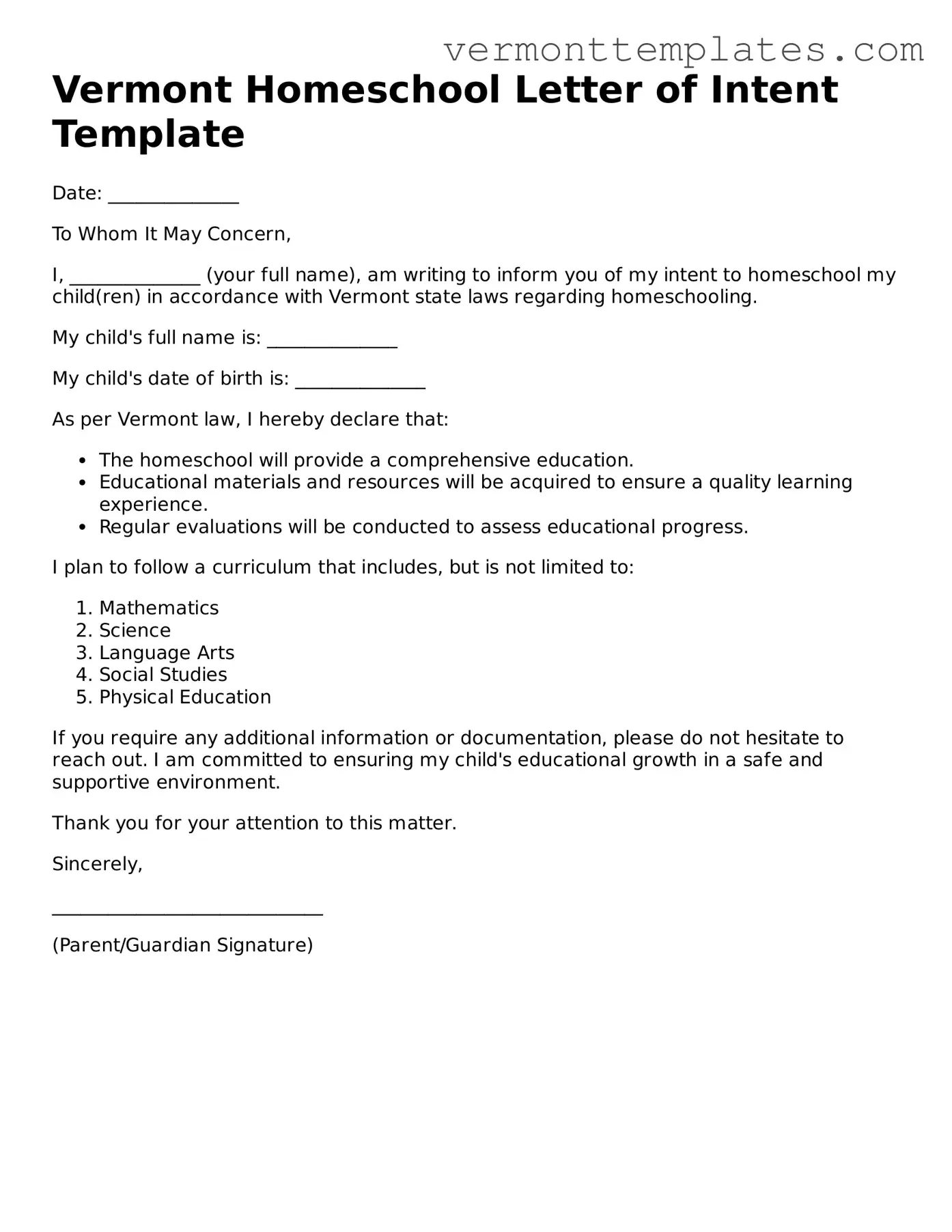The Vermont Homeschool Letter of Intent form shares similarities with the Notice of Intent to Homeschool form used in other states. This document is typically required by state education departments when parents decide to homeschool their children. Like the Vermont form, it serves as a formal notification that a parent or guardian is opting out of the traditional school system and intends to provide education at home. Both forms usually require basic information about the child and the educational plan that will be followed.
Another document that resembles the Vermont Homeschool Letter of Intent is the Educational Plan form. This document outlines the curriculum and educational strategies that parents will use during the homeschooling process. Much like the Vermont form, it emphasizes the parent's commitment to providing a structured learning environment. Both documents aim to ensure that the educational needs of the child are met while adhering to state requirements.
The Individualized Education Program (IEP) is also comparable to the Vermont Homeschool Letter of Intent. An IEP is created for students with special needs, detailing specific educational goals and accommodations. While the Vermont form is a general notification of homeschooling intent, the IEP focuses on tailored educational strategies for children with unique learning requirements. Both documents highlight the importance of meeting a child’s educational needs, albeit in different contexts.
The Affidavit of Homeschooling is another document similar to the Vermont Homeschool Letter of Intent. This affidavit is a sworn statement that parents must file with their local education authority, affirming their intent to homeschool. Like the Vermont form, it serves as a declaration of the parent's decision to educate their child at home. Both documents provide a legal basis for homeschooling, ensuring that parents comply with state regulations.
The Homeschool Registration form found in many states also mirrors the Vermont Homeschool Letter of Intent. This form requires parents to register their homeschool with the state or local education authority. It typically includes similar information, such as the names of the children being homeschooled and the educational approach being taken. Both forms serve to inform the authorities of the homeschooling arrangement and keep records updated.
For those interested in drafting an Operating Agreement tailored to their business needs, understanding the purpose and details involved is crucial. This is why accessing an essential template for an Operating Agreement template can be incredibly beneficial. This document helps ensure that all members of an LLC are on the same page regarding the structure and management of the business.
The Consent to Homeschool form is akin to the Vermont Homeschool Letter of Intent as well. This document is often required when parents wish to withdraw their child from public or private school to homeschool. It usually includes parental consent and may require signatures from both parents. Like the Vermont form, it formalizes the decision to homeschool and ensures that the child’s previous school is aware of the change in educational setting.
The Withdrawal Form from Public School is another document that shares similarities. When parents decide to homeschool, they often need to submit a withdrawal form to their child’s current school. This document notifies the school that the child will no longer attend and is transitioning to homeschooling. Both the withdrawal form and the Vermont Homeschool Letter of Intent serve to officially mark the change in educational status for the child.
The Curriculum Approval Form is also comparable to the Vermont Homeschool Letter of Intent. This form may be required in some states to ensure that the educational curriculum meets state standards. Like the Vermont form, it is part of the process to establish a homeschooling program. Both documents emphasize the importance of providing a quality education and keeping the educational authorities informed.
The Homeschool Evaluation Form can be seen as similar as well. This document is used to assess the educational progress of homeschooled children, often required by state law. While the Vermont Homeschool Letter of Intent is about the initial intent to homeschool, the evaluation form focuses on the ongoing assessment of a child’s education. Both documents highlight the commitment to ensuring that children receive a thorough education.
Finally, the Annual Homeschool Report is another document that resembles the Vermont Homeschool Letter of Intent. This report is typically submitted yearly to demonstrate that the child is making educational progress. Like the Vermont form, it serves to keep the educational authorities informed about the homeschooling situation. Both documents underscore the importance of accountability in homeschooling.
